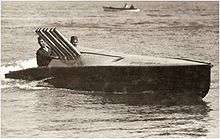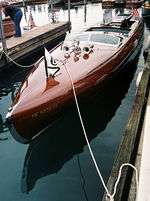Hacker-Craft
 | |
| Private company | |
| Industry | Boatbuilder |
| Founded | Early 1900s |
| Founder | John Ludwig Hacker |
| Headquarters | Silver Bay, Lake George, New York, United States |
Area served | Worldwide |
| Products | Motor Boats, Runabouts, Tenders, Racers |
| Website | hackerboat.com |
Hacker-Craft is the name given to boats built by The Hacker Boat Co., the oldest builder of wooden motorboats in the world. It is an American company, founded in Detroit, Michigan in 1908 by John Ludwig Hacker (known as John L. Hacker or just "John L."). The company moved operations to New York State in the 1970s and continues to produce hand-built boats in Silver Bay, on the shores of Lake George, New York.
John L. Hacker (1877–1961) was a naval architect and American motorboat designer. His major design and engineering accomplishments include the invention of the "V"-hull design and the floating biplane for the Wright brothers. Hacker's success in the design and building of speed craft surpassed all others of the time.
John L. Hacker, the early years

Hacker was born in Detroit, Michigan on May 24, 1877. For four years, while working at his fathers business as a book-keeper, he attended night school and took a correspondence course in order to become an accredited marine designer. Once qualified (at the age of 22) he set about solving a number of problems that inhibited speed and performance in motor boats. Pleasure boats of the 1900 era were narrow, round bottomed launches that plowed through the water instead of planing over it as boats do nowadays. Hacker's first major task in boat design was to try to solve the problem of "squatting", which occurred with all the canoe-stern shaped powerboats of the 1900s. His theory was that if his boats were going to go fast, they would have to "plane" rather than plow through the water, but the tendency to plane was considered a highly dangerous mode that was to be avoided. Nonetheless, he built a test craft to prove his new theories—a 30-foot (9.1 m) runabout. The boat's propeller and rudder were mounted under the transom and a strut was used to position the propeller shaft. The boat also featured Hacker's revolutionary "V"-hull design, which produced stunning speed and efficiency at low horsepower.
In 1904, he designed Au Revoir, the fastest boat in the world at the time, and on August 12, 1908, building on this success, he founded the Hacker Boat Company in Detroit, upon purchasing and renaming [1] an existing firm, Detroit Launch and Power Company. Coincidentally, this was the same day on which the first ever Model T Ford automobile was produced by his friend, Henry Ford.
His designs led to many advances that today's boat owners take for granted. Hacker's combination of design flair and engineering brilliance led him to create the shape and style that was to become the signature look of American speedboats. The list of his successes include: Pardon Me, the Minute Man, Thunderbird, El Lagarto, Bootlegger, Peerless, Dolphin, Kitty Hawk, Tempo VI, the Belle Isle Bear Cats, Lockpat II, and My Sweetie.
The birth of speed

In 1911, Hacker designed and installed two floats on the Wright Brothers' biplane so that it could take off and land on water. This was the first use of twin floats on an aircraft.
In the same year he designed Kitty Hawk, the first successful step hydroplane that exceeded the then-unthinkable speed of over 50 mph (80 km/h) and was then the fastest boat in the world. There followed a succession of Kitty Hawks, each building on the success of its predecessor and in the process breaking four sea-speed records.
In 1914, Hacker moved to Detroit and the Hacker Boat Company opened at 323 Crane Avenue. His runabout designs for Gregory's Belle Isle Boat & Engine Company were soon to bring success to the firm. The boats, called Belle Isle Bear Cats, proved popular with prominent owners like J.W. Packard and Henry Ford. The company was thriving and in 1921, Hacker decided it was time to open a satellite facility in Mount Clemens, Michigan. Two years later, he moved the entire boat building operation from Detroit to Mount Clemens.
Hacker Boat Company flourishes

The boat works on the Clinton River in Mount Clemens continued to expand, and by 1928 they provided 35,000 sq ft (3,300 m2) of floor space for the handcrafting of fine mahogany runabouts. That year the influential "Pageant of Progress" reported that the Hacker Boat Company employed sixty-eight men with demand growing rapidly. Sales for that year were $450,000 (about $5,000,000 2009 USD). His gleaming mahogany runabouts captured the public imagination with their elegant design and record-breaking speed and in the process quickly became the must-have play thing for the rich and famous.
In 1930 the King of Siam ordered a custom-built 40-foot (12 m) Landau-top runabout powered with an 800 horsepower (600 kW) Packard engine. Business was booming. Only four authorized dealers offered Hacker boats to the public during this period. The company did most of its business through factory direct orders from the customer, and excelled in custom-built craft. A Hacker Craft in the 1920s and 1930s, especially the bigger models, could always be spotted by their long front decks, three-piece sectional windshield and shiny chrome.
1930–1960
The Great Depression had a devastating effect on the pleasure-boat market, but in 1935 Hacker took on a business partner, John Mcready, who quickly assumed day-to-day control of the company. Meanwhile, Hacker focused on designing boats in what was to become his golden period: he was responsible for a remarkable number of racing winners including El Lagarto (which won the Gold Cup in 1933, 1934 and 1935), Scotty, Scotty Too, My Sweetie, Miss Pepsi—all record breakers.
In all, Hacker was responsible for over twenty water speed records, five Gold Cup winners, four President's Race winners and numerous other speed trials and racing victories.[2]
In Mount Clemens, Hacker Boat Company rebounded from the Depression with popular "utility" Hacker-Craft runabouts priced for the ordinary consumer. In 1935, the 17-foot (5.2 m) utility could be purchased for $975.00 ($13,000 2009 USD).
In 1939 Hacker was commissioned by property tycoon George Whitell to build what was to be one of his masterpieces and is now a national historic treasure, a 55 ft (17 m) commuter called Thunderbird. Considered to be one of the most beautiful wooden vessels of the 20th century, no sister ship has ever been built, despite requests to do so. Such is its status and history that Thunderbird was commemorated in 2007 by the U.S. Postal Service on a postage stamp.[3]
Business was strong, and in 1952, Hacker Boat was awarded a government contract for the construction of 25 ocean-going picket boats for the U.S. Navy and 112 40-foot-plus (12 m) crash boats, 20 ft (6.1 m) sedan utility boats, and target boats.[4] Hacker's designs included patrol boats, air-sea rescue boats, and cruisers.
Hacker Boat Company revitalized
In 1959 William Morgan of Morgan Marine, a boat-builder from Silver Bay, on Lake George, New York, acquired a controlling interest in Hacker-Craft with the aim of revitalizing the company's historic legacy. Having completed 60 Hackers already on the order books, they decided to increase production considerably.
Morgan Marine made significant structural and engineering modifications. The use of new technologies, unavailable to Hacker, allowed for improvements of the boats in a few subtle but important ways. First, engines were bigger. Where Hacker had used 110 hp (82 kW) engines, Morgan Marine was able to power these hulls with 350 hp (260 kW) or 454 hp (339 kW) Crusader engines that could eclipse 50 miles per hour. To accommodate these improved engines, Morgan Marine had to make the supports stronger than those used in the original designs. Morgan's biggest accomplishment, however, was improving the handling of the Hacker Crafts. If the old Hackers were run at top speeds, the bow could rise and block the driver's view. By reworking the bottom design, Morgan ensured that the boat would remain more level in the water.
At this time many of the original jigs had been lost, and, where necessary, they made new sand castings for the hardware. While retaining most of the traditional craftsmanship, Morgan made several significant improvements over the old plans, as concessions to the advancement of technology: dual exhausts, rather than the original single exhaust, for enhanced engine performance; the use of stainless steel fittings and hardware throughout so that pitting was no longer a problem; state-of-the-art epoxy encapsulation and bonding techniques; triple planked bottoms completely encased in epoxy; double planked sides and deck saturated in epoxy; 25 % more frames; double the number of floor timbers; up to 18 coats of varnish; the use of renewable-resourced Honduras mahogany; new improved steering for more maneuverability; and laminated windshields with either blue or green tints.
References
- ↑ http://www.successmagazinesltd.com/archives/july10PDFs/HackerBoats.pdf
- ↑ "The APBA Gold Cup". Retrieved 2012-06-15.
- ↑ "Title unknown". Archived from the original on October 7, 2009.
- ↑ Rhude, Andreas Jordahl. "Private Ship Builders Performing New Vessel Construction for the Military as of 01 July 1952". The Antique & Classic Boat Society. Retrieved 2012-06-15.
Further reading
- Barry, James P. (2002). Hackercraft. Voyageur Press. ISBN 0-7603-1107-2.
- Ballantyne, Philip B.; Duncan, Robert Bruce (2001). Classic American runabouts: wood boats, 1915-1965. MBI Pub. Co. ISBN 0-7603-0375-4. ISBN 978-0-7603-0375-7.
- Speltz, Robert (c. 1977). "Hacker Craft-the "Steinway" of Runabouts". The Real Runabouts. Lake Mills, IA: Graphic Publishing. pp. 26–35.
- Vincent, Maurice (1922). "John L. Hacker". The City of Detroit Michigan, 1701-1922. 5. Detroit: S.J. Clarke. pp. 659–660.
- "Sleek, Seaworthy "Cadet" Outboard Made in Mount Clemens Boat Works". Mount Clemens Daily Monitor-Leader. May 28, 1954. p. 2.
- "McCready Gets Contract for Navy Craft". Mount Clemens Daily Monitor-Leader. January 22, 1952. p. 1, col.5.
- "Hacker Boat Wins Coveted Army-Navy "E"". Mount Clemens Daily Monitor-Leader. February 15, 1944. p. 1, col.6.
- "Hacker Starts Work on Boat for a King". Mount Clemens Monitor. May 23, 1930. p. 2, col.6.
- "Hacker Company Was in Detroit, But Famous Boat Plant Came to This City in 1921". Mount Clemens Monitor. November 22, 1929. p. 7, col.7.
- "Hackercraft Boats Famous All Over World: Boat Company Spreads Name of Mt. Clemens". Pageant of Progress. Mount Clemens, Mich.: Nellis Newspapers. 1928. sec.3.
- "Hacker Has Built World Champs". Pageant of Progress. Mount Clemens, Mich.: Nellis Newspapers. 1928. sec.3.
- "Hacker Boat Works Expands: Will Employ 125". Mount Clemens Daily Leader. December 7, 1927. p. 1, col.8.
- "Hacker To Move Boat Works Here: Plant on the Clinton River to Be Enlarged". Mount Clemens Daily Leader. December 12, 1923. p. 1, col.1.
External links
- hackerboat.com—official site
- The Mariners' Museum, John L. Hacker Collection—the largest single archive of material relating to John Hacker and Hacker-Craft